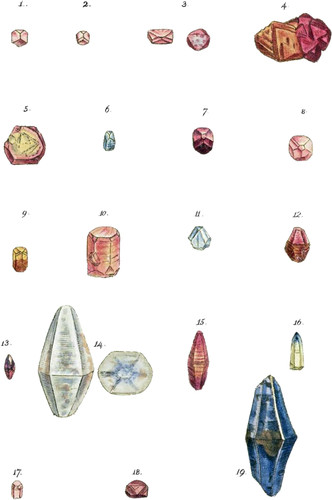 Enlarge
Enlarge
Exotic Mineralogy
Corundum, Ruby, and Sapphire
- Syn.
- Télésie, Haüy, Traité 2. 480.
- Rubis d’Orient, De Lisle, 2. 212.
- Saphir, Emmerl. 1. 67.
- Oriental Ruby, Oriental Topaz, Oriental Sapphire, Kirw. 1. 250.
- Corindon, Haüy, Tabl. 29.
Since the Count de Bournon’s elaborate treatise on Corundum in the Philosophical Transactions for 1802, little doubt has prevailed of the identity of it with those coloured Gems, distinguished by the Jewellers as Oriental Topaz, Ruby, Sapphire, Amethyst, and which prove to differ only in being purer, and consequently more transparent. They are at present all included under the specific name, Corundum.
I have exhibited in this plate a number of the crystals of Ruby and Sapphire in their un wrought state; excepting two or three, they are all selected by the Count de Bournon from his matchless collection, as fitted, not only to exhibit their general appearance, but to show their relation to Conmdum. No. 1 is the primitive rhomb with the obtuse solid angles truncated; this is a very rare variety, and shows admirably the coincidence of form with common Corundum. No. 2 shows the lateral edges also truncated, leading to the six-sided prism. Nos. 3, 4, 5, and 6, are difterent varieties of the same modification. Nos. 7 and 8 have in addition two small faces upon the lateral solid angles of the primitive, which lead to a dodecaëdron like No. 11. In Nos. 9 and 10 are the same modifications, but those of the column are much enlarged; the former shows two colours, half of the crystal being Oriental Topaz; the latter is from its extraordinary size and the perfection of its form, extremely valuable*; its form is nearly the same as that of the Corundum in tab. 45. No. 11 is a Sapphire on which the faces of the primitive rhomb remain, together with the truncated apex and the pyramidal plains, the prism being broken off No. 12, from the British Museum, is of the form formerly attributed to the Ruby, a dodecaëdron composed of two hexaëdral pyramids. No. 13 the same more perfect, with small remains of the primitive faces; this is of a purplish colour approaching to the Amethyst, No. 14 a very regularly formed dodecaëdral Sapphire, somewhat worn by attrition; this is in the British Museum, it was discovered there among a large parcel of rubbish remaining from Sir Hans Sloane’s Collection, some years since, by the Count de Bournon. Nos. 15 and 16 the hexaëdral pyramid united with tlie prism. No. 17 has, in addition to the faces in No. 10, the faces of a more acute pyramid. No. 18 is the primitive rhomb deeply trucated at its apex, and around the truncating plane are placed three striated facets similar to those of fig. 9 of the common Corundum in the next plate. No. 19 is an exceedingly fine acute dodecaëdron of Sapphire, the edges of which are truncated; the faces do not appear to be worn, it was lent me by the justly celebrated Chemist, Smithson Tennant, Esq.
It is observed that the smaller crystals of Corimdum are in general the most perfect; thus the smaller rubies are generally transparent, the larger ones are opaque in parts, less compact, and often even foliated in the direction of the primitive rhomb. The common Corundum is generally nearly opaque and ahvays foliated. The hardness of these Corundums, distinguished as gems, is superior to that of any other gems excepting the Diamond; their lustre and the purity of their colours, when transparent, is also very great, for which properties they have been highly valued for ages, and the more so in proportion to their size, and the degree of perfection of these qualities.
The Spec. Grav. of the Ruby varies from 3.939 to 4.087, the mean of twenty specimens being 3.977; and that of Sapphire from 3.907 to 4.161, the mean of 16 specimens was 4.016; see the Count’s paper. All the varieties are infusible excepting by the aid of pure Oxygen or a burning glass.
| Of the Ruby. | Of the Sapphire. | |
|---|---|---|
| Alumina | 90 | 92 |
| Silex | 7 | 5.25 |
| Iron | 1.2 | 1. |
| Loss | 1.8 | 1.75 |
- * One hundred and twenty guineas have been given for such an one.

